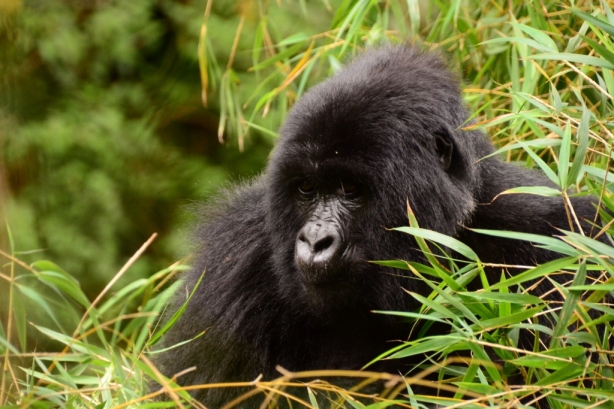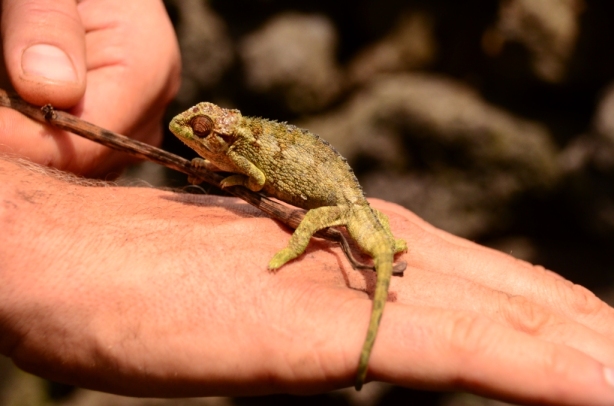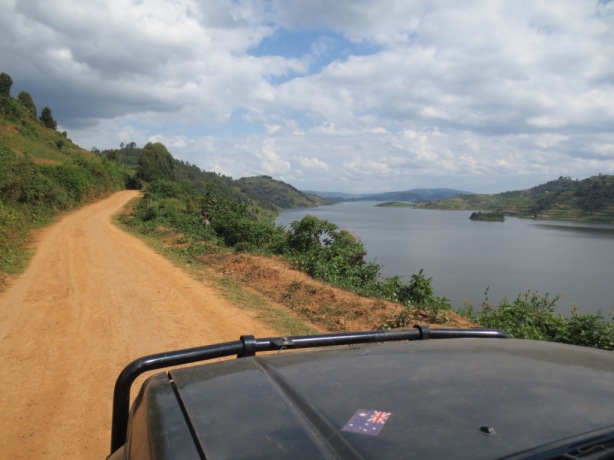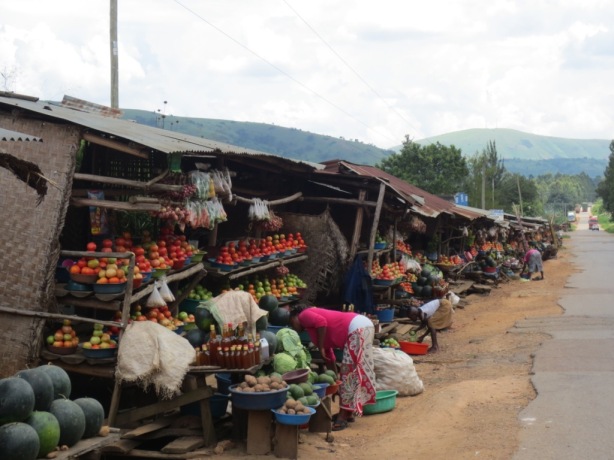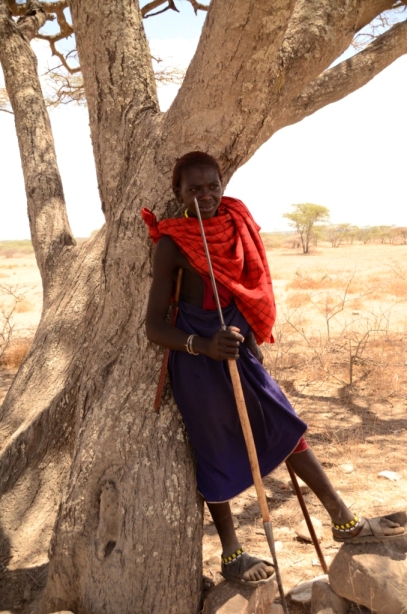Gorillas and growing walking sticks in Uganda
Day: 200
KLMS: 30,389
They say that in Uganda, if you a plant a walking stick it will grow. I can believe that! Heading into Uganda across the South Western border with Rwanda, the scenery became even more sensational with the free-standing volcanic mountain peaks providing a dramatic backdrop. With every inch of every hillside packed tightly with crops and vegetables, we saw a green more vibrant than we’ve ever seen before –it was just beautiful. We headed straight for the small, one-horse town of Kisoro to investigate options for gorilla trekking. Kisoro sits at the foot of the Mgahinga National park, the smallest, but probably the most spectacular of parks in Uganda made up of 3 volcanic peaks, where one family of 11 habituated gorillas are resident. The volcanic peaks provide a natural border for 3 countries, Rwanda, Uganda and the DRC. As the smaller, less-well known park we were hopeful that we would be able to book onto a trek within a few days, as tour operators within Rwanda and Bwindi, Uganda insist that bookings must be made months in advance. With only 8 people allowed to spend 1hour with a gorilla group each day, the demand is high. However, it was low season and when we arrived at the parks office we could not have been happier to hear that not only could we go the very next day, it would also just be the 2 of us! That night we excitedly packed up our supplies, we’d heard that depending on where the gorillas are you can be trekking for up to 8hours through steep, jungle terrain so we made sure we’d packed plenty of food and water. Then it was up early to head out to the park, trying to make sense of the very basic map the park ranger had drawn for us the previous day. Having woken with what we thought was plenty of time, we realised that we hadn’t actually checked if the time-zone had changed when we crossed the border. Yep, we were actually an hour ahead, so what should have been a slow drive down rough tracks became a mini Dakar rally to get to the park on time!
We were given a quick briefing and introduced to our guide and a ranger, who I was very pleased to see carrying a big gun. I wasn’t sure if this was for gorillas gone bad, stray elephants or considering that this was the DRC border, maybe a rebel or two? I thought it best not to ask, so we started our journey into the thick vegetation. We trekked for about an hour and half, the humidity was stifling, but at least the rain held off, it was already very wet and slippery underfoot and we both took a number of spills along the way. But then the guide’s radio crackled into life with the good news from the trackers ahead that they had found the gorillas. We picked up the pace, the guide following the instructions from the trackers to where they were waiting for us.
We were given a quick briefing, before taking the final couple of hundred meters to where the gorillas were feeding. As we approached the trackers began their grunting calls to the gorillas and within seconds the gorillas responded with grunts and yelps to tell the whole family of our approach. As we rounded the corner, there in front of us was a huge Silverback starring straight back at us. To see such a huge animal, only meters away, with no fence inbetween, was incredible. My heart was almost pounding out of my chest! The silverback looked unimpressed, realising it was only humans and nothing to worry about, he moved off slowly into the thick undergrowth, so the guide took us forward slowly to begin following them. As we got to where the Silverback had originally been standing, we looked around to see that the entire family were all feeding around us. We sat and watched as two females and their babies, one of which was only 2 days old, munched their way through the bamboo canes only feet away from us.
As they grazed, they kept moving, so the trackers had to begin to hack their way through the thick undergrowth with machetes to keep up with them. It was hard work! But fortunately the Silverback decided to stop again and sat down curiously looking back at us. We waited silently to see what he’d do next and deciding that we were still ok, he began to lie back and roll around on the floor, flattening out a nice grassy patch which he could nest in. He lay on his back, arm underneath his head, occasionally lolling his head over to stare at us with his beautiful big, black eyes. He was so human-like it was uncanny. In his relaxed state, we were able to gradually edge close, until we were sitting only feet away. He of course, still had to asset his dominance over the situation and when he suddenly jumped up to his feet and banged on his chest with his fists, we both got one hell of scare, it was a squeaky bottom moment, but the trackers reassured us he was just showing off so just to remain still and quiet. We spent the most wonderful hour, with what must be one of natures’ most magnificent animals, but it was over all too soon and as the time was up we had to say goodbye to the gorillas. At $500 each, it wasn’t cheap, but was it worth it? Yes, every dollar, I just wish I was rich enough to go everyday!
After our amazing gorilla encounter we headed onto Lake Bunyoni, where the scenery just got more and more beautiful. The drive up to the lake has to be one of our favourite drives of the trip and we wound our way along the lake shore to a beautiful little campsite, Kalebask, set in a neatly manicured, flower-filled garden; mum and dad would definitely have approved!
The staff were so friendly, we were the only ones there, so could definitely have stayed at our ‘exclusive camp’ for longer. Moving on, we headed towards Kampala, where due to ‘imminent Westgate style attacks’ we decided to just drive through and stay out in Jinja. The traffic in Kampala is like nothing else on this planet! We were soon stuck in gridlock, with cars stretching for miles ahead. As we crawled along, cars, bikes, people were trying to force their way through the smallest gaps, the road was just a mess of cars at all angles, no regard for lanes or road rules! We joined in, our car being bigger than most we were willing to start using our bullbar to ram our way through! It took hours to cross Kampala and although we had plans to find somewhere lovely for lunch we couldn’t face the traffic any longer so continued towards Jinja and an amazing camp on the banks of our new friend, the Nile, who will be our constant companion as we travel north. The view from the camp was stunning, and the birdlife is unbelievable. Although not particularly birdy-people even we were impressed with the colourful array of feathered-beings that frequented the Nile’s shores. We have absolutely loved our time in Uganda, there is still so much more we want to see, but with park fees to Bwindi, Queen Elizabeth and Murchison Falls all in excess of $100 per day, they will have to wait until next time! Now we need to move onto Kenya!




